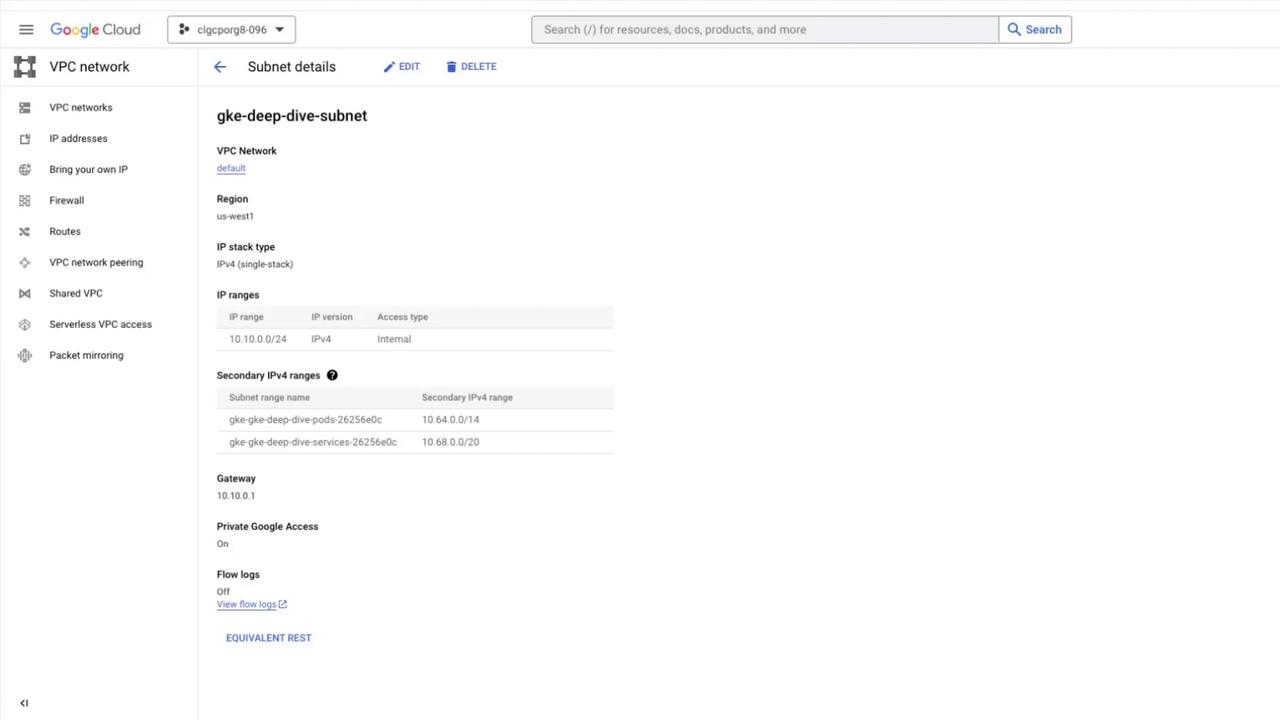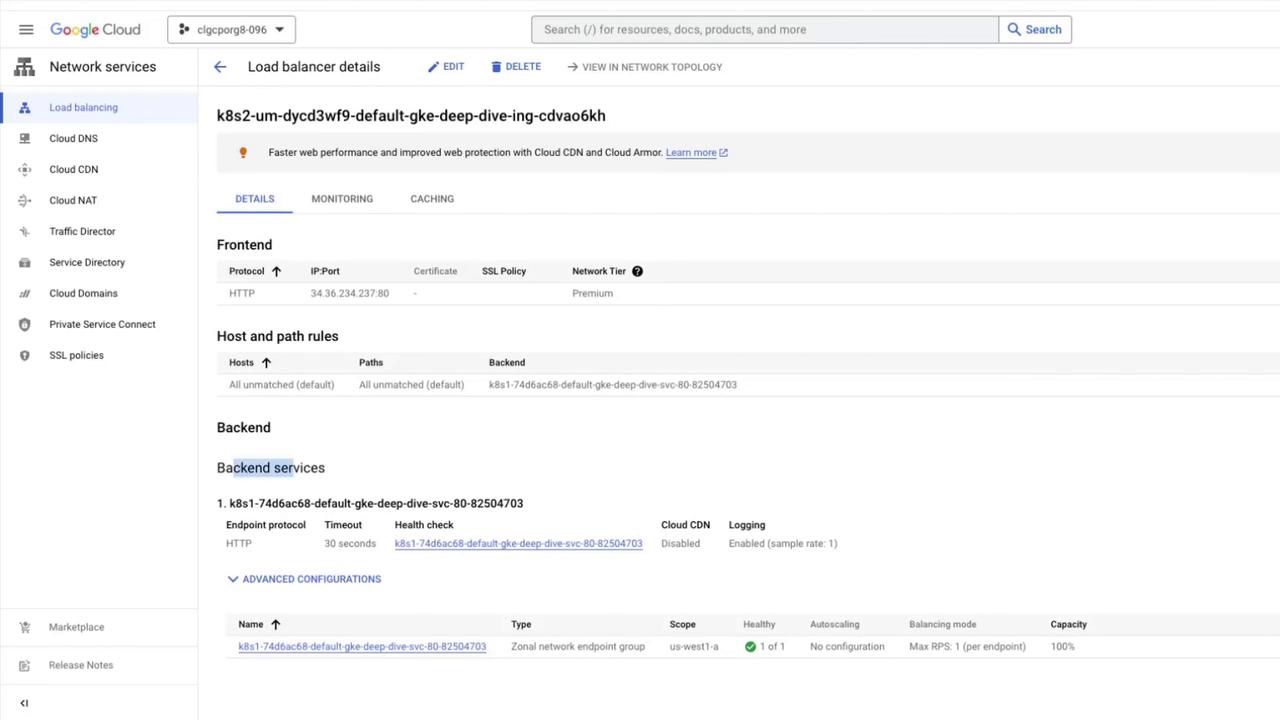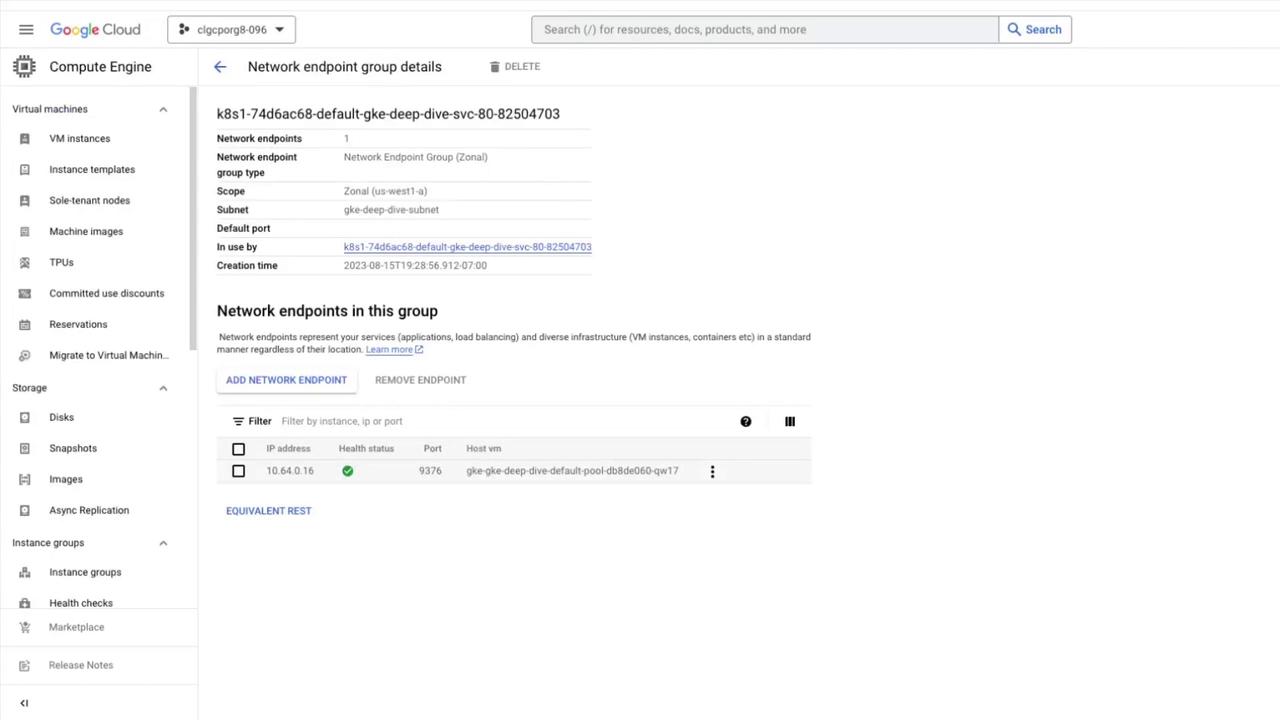GKE - Google Kubernetes Engine
Networking for GKE clusters
Demo Configure container native load balancing using Ingress
In this tutorial, you’ll learn how to set up container-native load balancing for your GKE applications using Ingress and Network Endpoint Groups (NEGs). We’ll cover:
- Creating a custom subnet in your VPC
- Provisioning a VPC-native GKE cluster with IP aliasing
- Deploying a simple HTTP server
- Exposing it via Ingress backed by a NEG
- Viewing the resulting Load Balancer and NEGs
- Scaling the deployment and validating load balancing
This end-to-end guide uses Google Cloud Platform commands, Kubernetes manifests, and Console walkthroughs.
1. Create a custom subnet
First, create a /24 subnet in the default VPC in us-west1:
gcloud compute networks subnets create gke-deep-dive-subnet \
--network=default \
--region=us-west1 \
--range=10.10.0.0/24
You can verify the new subnet under VPC networks > default VPC in the Cloud Console.
Note
Choose a CIDR range that doesn’t overlap with your existing networks. This subnet will host both Pods and Services via secondary IP ranges.
2. Provision a VPC-native GKE cluster
Set your Compute region and zone, then create a GKE cluster with IP aliasing enabled on the custom subnet:
gcloud config set compute/region us-west1
gcloud config set compute/zone us-west1-a
gcloud container clusters create gke-deep-dive \
--num-nodes=1 \
--disk-type=pd-standard \
--disk-size=10 \
--enable-ip-alias \
--subnetwork=gke-deep-dive-subnet
Note
Cluster provisioning typically takes 10–15 minutes. Verify that two secondary IP ranges (for Pods and Services) appear under your subnet.

3. Deploy the HTTP server application
We’ll deploy a basic HTTP server that responds with its Pod hostname.
3.1 Deployment manifest
Create a file named gke-deep-dive-app.yaml:
apiVersion: apps/v1
kind: Deployment
metadata:
name: gke-deep-dive-app
labels:
app: gke-deep-dive-app
spec:
replicas: 1
selector:
matchLabels:
app: gke-deep-dive-app
template:
metadata:
labels:
app: gke-deep-dive-app
spec:
containers:
- name: gke-deep-dive
image: gcr.io/google-containers/serve_hostname
ports:
- containerPort: 80
protocol: TCP
Apply and verify:
kubectl apply -f gke-deep-dive-app.yaml
kubectl get pods
3.2 Service manifest
Expose the Deployment as a ClusterIP Service annotated for NEGs. Save as gke-deep-dive-svc.yaml:
apiVersion: v1
kind: Service
metadata:
name: gke-deep-dive-svc
annotations:
cloud.google.com/neg: '{"ingress": true}'
spec:
type: ClusterIP
selector:
app: gke-deep-dive-app
ports:
- name: http
port: 80
protocol: TCP
targetPort: 80
Apply and confirm:
kubectl apply -f gke-deep-dive-svc.yaml
kubectl get svc
3.3 Ingress manifest
Create gke-deep-dive-ing.yaml to route HTTP traffic via Ingress:
apiVersion: networking.k8s.io/v1
kind: Ingress
metadata:
name: gke-deep-dive-ing
spec:
defaultBackend:
service:
name: gke-deep-dive-svc
port:
number: 80
Apply the Ingress:
kubectl apply -f gke-deep-dive-ing.yaml
kubectl get ingress
Warning
An EXTERNAL-IP may take a few minutes to appear. Wait until it’s provisioned before testing.
Once you have the IP, browse to:
http://<EXTERNAL_IP>
You should see the hostname of the serving Pod.
3.4 Resource manifest overview
| Resource Type | File | Purpose |
|---|---|---|
| Deployment | gke-deep-dive-app.yaml | Deploy basic HTTP server |
| Service | gke-deep-dive-svc.yaml | Expose Pods with NEG annotation |
| Ingress | gke-deep-dive-ing.yaml | Route external HTTP traffic via Ingress |
4. View Load Balancer and NEG
In the Cloud Console, go to Network services > Load balancing. You’ll see an HTTP(S) Load Balancer created for your Ingress:

Click the Load Balancer name to view both frontend and backend configurations:

Select the backend service to inspect the NEG:

5. Scale and verify load balancing
Increase the Deployment to three replicas:
kubectl scale deployment gke-deep-dive-app --replicas=3
kubectl get deployment gke-deep-dive-app
Refresh your browser at the Ingress IP. You’ll see responses cycling through the three Pod hostnames, demonstrating container-native load balancing via Ingress + NEGs.
Links and References
- GKE documentation
- Kubernetes Ingress Guide
- Network Endpoint Groups
- VPC-Native Clusters (IP Aliasing)
- Google Cloud Console – Load Balancing
Watch Video
Watch video content